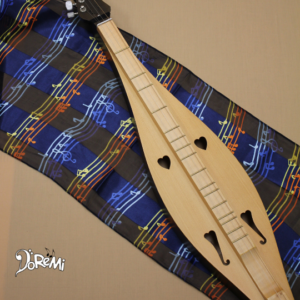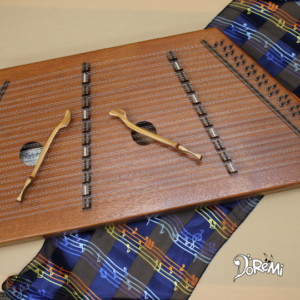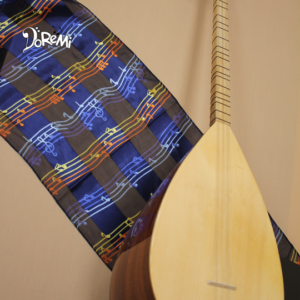Stringed Instruments You May Not Know
One of the things we like to impress upon our students, is that once you have learned to play one instrument in a family, such as the strings, you can apply that knowledge to learning how to play any other similar instrument. Although I started with the guitar, I have since collected dozens of instruments that have strings. These include the normal ones, of course, like the violin, cello, double bass, banjo, and mandolin. But, there is a world full of unique and amazing stringed instruments that are fun to learn, and to share.
Autoharp
The autoharp is one of the easiest stringed instruments to begin to learn to play. It is a member of the chorded zither family. What makes it unique, is the fact that it has a series of dampers, which when pressed, mute all of the strings that don’t belong to the chord you are playing.
The origin of the autoharp is a topic of debate. In 1882, a US patent was awarded to Charles Zimmermann, a German immigrant in Philadelphia, for the design of a symmetrical musical instrument that included a horizontal mechanism for muting strings. He named his invention the “autoharp”, but it is not known if he ever produced this instrument commercially. Around the same time in Germany, Karl Gütter obtained a British patent for an instrument quite similar to the autoharp as we know it today, which he called the Volkszither. After a visit to Germany in 1885, Zimmermann can back to the US and began production of the Gütter design, using his own patent number and name. The instrument became very popular, and Zimmermann has often been misnamed as the inventor.
Although the actual term autoharp was once the trademark of the Oscar Schmidt company, it has since come to be used for any hand-held chorded zither no matter the manufacturer.
Mother Maybelle Carter of the original Carter Family brought the instrument to prominence in the late 1940s, using it as a lead instrument when performing with her daughters. A vast number of recordings by all members of the Carter Family include the use of the Autoharp.
Other well-known artists who played the autoharp include Janis Joplin, John Sebastian of the Lovin Spoonful, the comedian Billy Connolly, and Brittain Ashford.
Appalachian dulcimer
 The Appalachian dulcimer is a fretted stringed instrument also from the zither family. It is known by many different names: the lap dulcimer, mountain dulcimer, teardrop dulcimer, Kentucky dulcimer. The instrument also has a number of interesting nicknames including hog fiddle, harmony box and mountain zither.
The Appalachian dulcimer is a fretted stringed instrument also from the zither family. It is known by many different names: the lap dulcimer, mountain dulcimer, teardrop dulcimer, Kentucky dulcimer. The instrument also has a number of interesting nicknames including hog fiddle, harmony box and mountain zither.
Few historical records of this dulcimer exist, and its origin has been open to much speculation. It first appeared in the early 1800s among the Scottish and Irish immigrant communities in the Appalachian mountains. Several similar folk instruments exist throughout Europe, including the Swedish hummel, the Norwegian Langeleik and the German scheitholt. Charles Maxson, an Appalachian luthier from Volga, West Virginia, speculated that one of the factors leading to the invention of the dulcimer was that early settlers were unable to make the more complex violin in those early days due to lack of both tools and time. He felt that the early dulcimers would have been modelled on those folk instruments known in Europe.
Few specimens of the mountain dulcimer exist from earlier than about 1880, when J. Edward Thomas of Knott County Kentucky began building and selling them. Because of their modest sound volume, they would have been used primarily as parlour instruments. For the first half of the 20th century, the dulcimer was rare, and no recordings of the instrument occur until the late 1930s.
The instrument achieved its full recognition during the 1950s urban folk music revival in the United Sates. This was largely due to the work of Jean Ritchie, a Kentucky musician who performed with the instrument for New York City audiences. By 1965, the dulcimer was a familiar presence in folk music circles and is now a core instrument in the American old-time music tradition.
Although the mountain dulcimer was long associated with the older generations, it also gradually attracted a number of younger players. Brian Jones of the Rolling Stones played the dulcimer on several recordings and during many live performances. Joni Mitchell played the instrument on studio recordings in the 1960s, most famously on the album Blue, as well as in live performances. Cyndi Lauper is also a high-profile mountain dulcimer player.
Hammered dulcimer
 The hammered dulcimer is a percussion-stringed instrument. It consists of a trapezoidal resonant sound board with several courses of strings stretched over a couple of bridges. It sits in front of the musician who plays it with small spoon-shaped mallets.
The hammered dulcimer is a percussion-stringed instrument. It consists of a trapezoidal resonant sound board with several courses of strings stretched over a couple of bridges. It sits in front of the musician who plays it with small spoon-shaped mallets.
The dulcimer comes in a variety of sizes, depending on the number of strings. The usual sizes span either 2 or 3 octaves. The strings of the hammered dulcimer are tuned according to the circle of fifths, breaking the diatonic scale into two tetrachords with the lower notes on the right and the higher notes on the left.
Hammered dulcimers and other similar instruments are traditionally played all over the world, from the Middle East to Asia, Europe, the United Kingdom, and the folk music of the US. Each has its own distinct manner of construction and playing style. In North American, they are often seen at Medieval and Renaissance festivals.
Lap Steel Guitar
 Also known as the Hawaiian guitar, this type of guitar is played in a horizontal position, usually across the lap, using a steel bar to stop the strings.
Also known as the Hawaiian guitar, this type of guitar is played in a horizontal position, usually across the lap, using a steel bar to stop the strings.
The instrument originated in the Hawaiian Islands around 1885 when an Oahu youth, Joseph Kekuku, first played a traditional guitar in this manner. He became proficient at it, and the instrument’s ability to smoothly glide between notes became popular throughout the islands. American popular culture became fascinated with Hawaiian music during the first half of the 20th century, and the steel guitar began to meld into other musical styles including blues, gospel and especially country music.
Spanish guitars had been introduced into the Islands as early as the 1830s, but Hawaiians did not embrace the standard tuning that had been used for centuries. Instead, they re-tuned the guitars to make a chord when all the strings were sounded together. Known as “open tuning”, the lap steel is usually tuned to open E, D, G or A. We tend to choose open G, where the strings are tuned (lowest to highest) to D-G-D-G-B-D, playing an G major chord.
Our guitars are all Dobro, or resonator, guitars. This is a unique American steel guitar with a resonator cone designed to make the guitar louder. It was patented in 1927 by the Dopyera brothers (hence the Do-bro), but the name has since become a generic term for any similar type of guitar.
Beecher “Pete” Kirby introduced the instrument to a nationwide radio audience in 1939. As a member of the Smoky Mountain Boys, and through his performances on the Grand Ole Opry, Kirby helped define country music in its formative years. Buck “Josh” Graves played the dobro in the pioneering bluegrass band, Flatt and Scruggs, in 1955. Taking the instrument to a new level with lightening fast solos, Graves established the dobro as a common fixture in a bluegrass band.
Nyatiti
 The nyatiti is a traditional instrument from the lute family, native to the Luo people of Western Kenya. It has a bowl-shaped carved resonator covered in cow skin, and a wooden frame for stretching 5-8 strings. Historically, strings were fashioned from cattle tendons, but modern players use nylon and plastic fishing line, and even cello strings, which has changed the sound of the nyatiti dramatically.
The nyatiti is a traditional instrument from the lute family, native to the Luo people of Western Kenya. It has a bowl-shaped carved resonator covered in cow skin, and a wooden frame for stretching 5-8 strings. Historically, strings were fashioned from cattle tendons, but modern players use nylon and plastic fishing line, and even cello strings, which has changed the sound of the nyatiti dramatically.
The nyatiti as played in Kenya usually has eight strings. The tuning will often vary to match the comfortable singing range of the player, but typically from bottom to top would be B-A-G#-E-E-D-B-A, where the outside notes are the same and the middle ones an octave apart.
If played in a traditional style, the performer sits on a short stool wearing a wrought iron ring on the toe of the right foot attached to bells or shakers around the ankle. The player maintains a steady beat with the foot while playing the strings with the thumb and middle finger of both hands, alternating between the two to create a rhythmic and circular musical pattern.
Erhu
 This traditional Chinese instrument is not well known in most parts of North America. It can be traced back to proto-Mongolic instruments which appeared in China during the Tang Dynasty (618-906 A.D.).
This traditional Chinese instrument is not well known in most parts of North America. It can be traced back to proto-Mongolic instruments which appeared in China during the Tang Dynasty (618-906 A.D.).
The erhu is a member of the bowed zither family, and is often referred to as the Chinese violin. It consists of a long vertical stick-like neck with two tuning pegs at the top and a small resonator body at the bottom. This sound box is covered with python skin on the front, giving the erhu its unique sound. The two strings are tune to D4 and A4, and the bow passes in between them. The erhu has no fingerboard, and the player stops the strings by pressing on them gently with the fingertips.
A very versatile instrument, the erhu has a vast repertoire as a solo instrument, but is also played in small ensembles and large orchestras. It is used in both traditional and contemporary music arrangements such as pop, rock and jazz. The erhu is one of the main instruments in regional music ensembles such as Jiangnan sizhu, Chinese opera ensembles and the modern large Chinese orchestra. It is used in the music of the Cirque du Soleil show O, and in some Shen Yun tours. The erhu has also appeared in several soundtracks including Earth: Final Conflict, World of Warcraft: Mists of Pandaria, and is featured in several cues related to Vulcans in the 2009 movie Star Trek.
Bağlama
 The bağlama or saz is another traditional instrument that isn’t well known in North America, although it is the most commonly used string folk instrument in Turkey. It is a member of the lute family and comes in various sizes.
The bağlama or saz is another traditional instrument that isn’t well known in North America, although it is the most commonly used string folk instrument in Turkey. It is a member of the lute family and comes in various sizes.
Like the Western lute and the Middle-Eastern oud, it has a deep round back, but a much longer and thinner neck. The bağlama has seven strings divided into sets (or courses) of two, two and three. The strings can be tuned in a variety of ways, including la-sol-re, sol-re-la or fa#-re-la. Frets are tied to the neck with fishing line, which allow them to be adjusted. The instrument is played either with the fingers or with a plectrum.
The musical scale of the bağlama differs from that of many western stringed instruments such as the guitar, in that it features ratios that are close to quarter tones rather than half tones. Modern instrument makers, however, are beginning to set frets on the bağlama with the aid of fret calculators and tuners based on the 24-tone equal temperament system.


